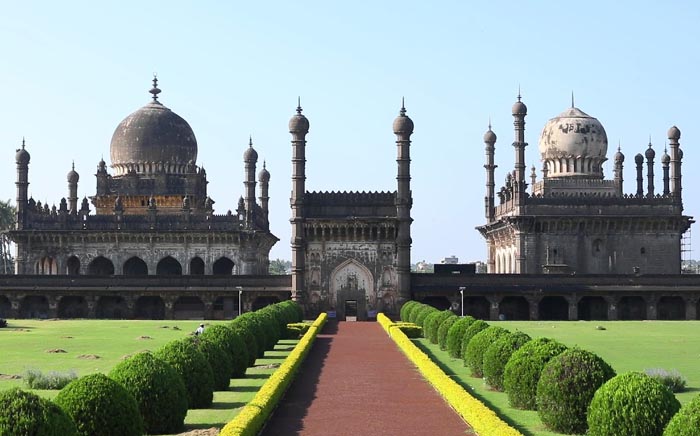Ibrahim Roza

Information on Ibrahim Roza (Bijapur, Karnataka) - History & Architecture
Ibrahim Roza is a beautiful historical monument in Bijapur of Karnataka State in India. It is a mausoleum built for its great Emperor name Ibrahim Adil Shah II. This is a Persian architectural marvel worth to see.
Ibrahim Roza Architecture
Ibrahim Roza is totally built in the Persian architectural pattern. It architect was Malik Sandal, who was a great architect in the 16th century. His contribution to Islamic structure is mostly found in the Bijapur City. This tomb was built here in the similar style of those structures found on the Taj Mahal. He may be thought to build similar structure here. This tomb is built in a beautiful garden with a thick wall enclosure. There is also a mosque seen in the opposite of this tomb. This is adjoined with a lovely pond. The entire ambience is looking pleasant in a greenery filled gardens and a pond here. This mausoleum is built with a centrally place gol gumbaz, either a large and huge cylindrical dome on its centre of the tomb. It is build over a 5 feet height platform. It is a square structure in shape. There is an entrance for this mausoleum with two small pillars, which have a globe like structures on its top. The main structure is supported with pillared corridors on its four side of this structure. On the top edges there are four beautifully craved minarets found. These minarets along with the gol gumbaz look very attractive in nature. The height of these minarets is 24 meter. The Mosque built here does have similar minarets and gol gumbaz. Inside there are few complexes built here. There is also a secret passage built here. This leads to few storage rooms under the basement of this platforms. The center of this structure is where, two tombs are constructed. It was the tombs of Adil Shah II and his Queen named the Taj Sultana. But later his family members were also buried here. It consists of his mother and 2 sons. The upper portion of this tomb has the splendid art work of the gol gumbuz. This has many floral designs on it. There are unique carving art works found on its top areas. Its edges connecting its roofs are little bit projected outside and these are supported with carved small stone supports. It alignment looks very unique on all side of this structure.
Ibrahim Roza History
Ibrahim Roza is a standing beautiful landmark in the Bijapur City. The Bijapur Dynasty is known to build many Islamic structure her under the supervision of Malik Sandal. It was his architectural designs which look very amazing here. The government of Karnataka has also opened many of the architectural institute here. These are of Engineering and structural studies. The Bijapur Dynasty emerged as power full rulers in the medieval time. Previously this place was occupied by the Chalukyan from the 10th to 11th century AD. This place was well known as the Vijayapura. In the 13th century it was ruled by the Islamic ruler named the Khilji Dynasty. They renamed it to Bijapur. In the advent of the 16th century the Bhamani Sultans occupied this land. Hence the Adil Shah's clans ruled this province. This place was later conquered by the Mughal's of the North Delhi. It went to the British east India Company only in the 19th century AD.
Ibrahim Roza Tourism Importance
Ibrahim Roza is the tomb of king and Queen of Bijapur Dynasty. It is an Islamic architectural marvel very beautiful to look. This is a protected monument and a heritage site in Karnataka. It is a great tourist destination for rich history, culture and architectural significance.
- Bangalore Monuments
- Bagalkot Monuments
- Belgaum Monuments
- Bellary Monuments
- Bidar Monuments
- Bijapur Monuments
- Chitradurga Monuments
- Coorg Monuments
- Dakshina Kannada Monuments
- Gadag Monuments
- Gulbarga Monuments
- Hassan Monuments
- Mysore Monuments
- Raichur Monuments
- Uttara Kannada Monuments
- Yadgir Monuments
- Andaman Nicobar Monuments
- Andhra Pradesh Monuments
- Assam Monuments
- Bihar Monuments
- Chhattisgarh Monuments
- New Delhi Monuments
- Goa Monuments
- Gujarat Monuments
- Haryana Monuments
- Himachal Pradesh Monuments
- Jammu and Kashmir Monuments
- Karnataka Monuments
- Kerala Monuments
- Madhya Pradesh Monuments
- Maharashtra Monuments
- Odisha Monuments
- Punjab Monuments
- Rajasthan Monuments
- Tamil Nadu Monuments
- Telangana Monuments
- Uttar Pradesh Monuments
- West Bengal Monuments